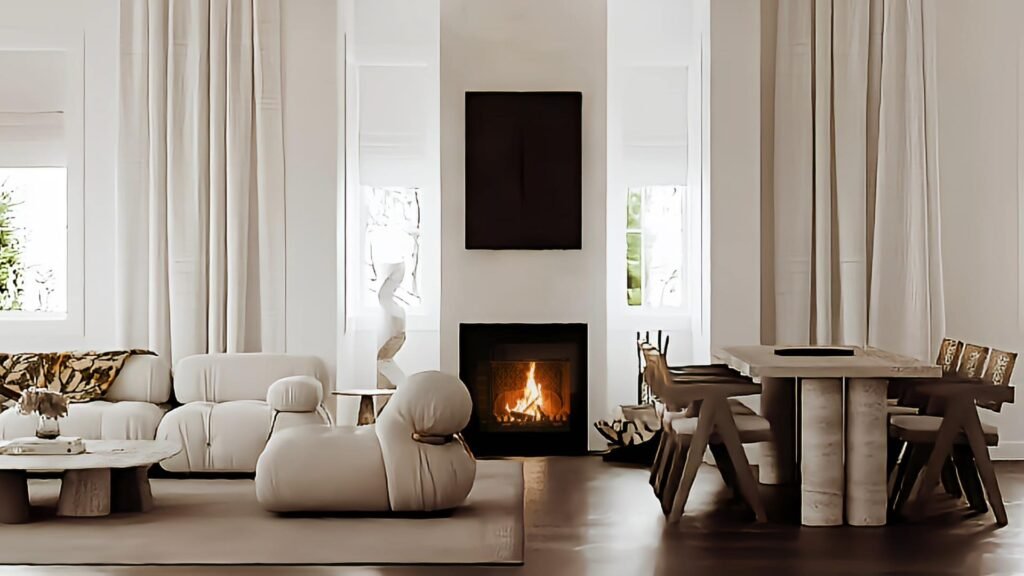Discover the transformative power of open living and dining areas in contemporary design. This blog post explores the versatility and aesthetic benefits of open spaces, showcasing key elements that enhance functionality and style. Learn about innovative design ideas that merge indoor and outdoor environments, effective color palette choices, and furnishing tips that create an inviting atmosphere. Whether you’re looking to maximize your space or incorporate personal touches, this guide provides inspiration for crafting harmonious living areas that reflect modern lifestyles.
Introduction to Open Spaces
The concept of open spaces has gained significant traction in contemporary design, redefining the way we think about living environments. Open spaces blur the lines between functionality and aesthetics, particularly in the context of combining living and dining areas. This design approach fosters a sense of connection and fluidity, creating an inviting atmosphere that is both practical and visually appealing. As modern lifestyles evolve, homeowners increasingly seek to enhance their living conditions by eliminating barriers typically found in traditional layouts.

One of the most compelling aspects of open spaces is their versatility. By merging different areas, such as the living room and dining room, a more cohesive environment is achieved. This design allows for effortless interaction among family members and guests, facilitating social gatherings and daily activities alike. The open layout can even give the illusion of a larger space, which is particularly advantageous in smaller homes or apartments. It creates a harmonious flow that effortlessly integrates various functions without the need for obstructive walls.
Please read our article watch the newly uploaded video from our YouTube channel:
“Grig Stamate – Interior Design Solutions”
https://www.youtube.com/@GrigStamate
ELEGANCE UNVEIILED: Stunning Living/Dining Areas (Open Spaces) You Must See! (video)
Here, you can see other related videos from our channel:
ELEGANCE UNVEIILED: Black Accents for Modern Interior Decor (video)
ELEGANCE UNVEIILED: 60 Simple Dining Room Styling Ideas (video)
Moreover, the aesthetic benefits of open spaces cannot be overstated. They encourage a cohesive design throughout the home, offering opportunities for creative interior styling. With fewer walls to divide areas, features like natural light, color palettes, and decor can be unified, resulting in a more balanced overall appearance. As a result, open spaces are not just functional; they deliver an enhanced visual experience that captures the essence of modern living.
As we delve deeper into the advantages and characteristics of open living/dining areas, it becomes evident why they are a favored choice in contemporary homes. Their potential to elevate both comfort and style makes them a transformative aspect of modern interior design.
Benefits of Open Living/Dining Areas
Open living and dining areas have become increasingly popular in modern home design, and for good reason. One of the most significant advantages of these spaces is the influx of natural light. Without walls dividing the living area from the dining space, sunlight can penetrate deeper into the home, illuminating the entire room. This not only enhances the aesthetic appeal but also contributes to a healthier living environment, as natural light has been linked to improved mood and overall well-being.
Another notable benefit of open living and dining areas is the improved flow and functionality they provide. The absence of barriers fosters a seamless transition between different zones, making the space feel more cohesive. This layout allows for greater flexibility in furniture arrangements and promotes a sense of spaciousness. In smaller homes, open spaces can create the illusion of a larger area, effectively minimizing feelings of confinement and enhancing comfort.
Moreover, open living and dining areas are particularly conducive to social interaction. The expansive layout encourages family members and guests to engage more easily with one another, regardless of their location within the space. This interconnectedness proves invaluable during gatherings, as it allows hosts to mingle with guests rather than isolating themselves in a separate dining room. As a result, the atmosphere becomes more inviting, enriching social experiences and fostering a sense of community.
In addition to these advantages, open living and dining areas can adapt effortlessly to a variety of design styles, further enhancing their appeal. Whether your aesthetic leans toward minimalism or eclecticism, the versatility of open spaces allows for a personalized touch that resonates with individual tastes. Overall, the benefits of open living and dining areas significantly enrich the overall living experience.
Key Elements of Stunning Open Spaces
Creating a stunning open living and dining area involves a harmonious blend of various design elements that come together to form an inviting and functional space. One crucial element is the color scheme, which sets the tone for the entire area. Choosing a cohesive palette that complements both the living and dining sections can help unify the space. Soft, neutral tones are popular for creating a calm atmosphere, while bold accent colors can inject personality and vibrancy. It is essential to consider the natural light in the area, as it influences how colors appear throughout the day.
Another significant factor is furniture selection. Opting for multifunctional pieces can maximize space efficiency, especially in smaller areas. For instance, a dining table that can extend to accommodate larger gatherings, or a stylish sofa that doubles as a sleeper, can enhance the functionality of the space. Additionally, selecting furniture with appropriate scale is necessary to avoid overcrowding. Consider using pieces that are visually lightweight to maintain an open feel, which encourages fluid movement throughout the area.
Layout considerations are essential in designing an open space. Establishing distinct zones for dining and living while ensuring flow and accessibility is vital. A well-planned layout can optimize space usage, allowing for comfortable interaction and activity. Incorporating area rugs can define these zones without partitioning the space physically, thus maintaining the open concept.
Finally, lighting plays a pivotal role in setting the atmosphere of an open living and dining area. Combining multiple light sources, such as ambient, task, and accent lighting, can create a layered effect that enhances the overall design. Soft illumination from pendant lights over the dining table and strategically placed floor lamps will contribute to a warm and inviting ambiance. Ultimately, integrating personal style into these elements ensures that the space reflects the inhabitant’s character.
Innovative Designs for Inspiration
In the realm of contemporary interiors, innovative designs play a pivotal role in redefining living and dining areas into stunning open spaces that captivate and inspire. The following showcase features a selection of nearly 60 remarkable designs that embody current trends, incorporating elements of minimalism, maximalism, and eclectic styles. Each design stands out due to its unique features and the thoughtful integration of aesthetics and functionality.
Minimalism dominates several designs, offering clean lines, neutral palettes, and a serene atmosphere. Such spaces emphasize simplicity by utilizing open layouts that create a sense of airiness. Furnishings in these settings often serve dual purposes, ensuring that every piece contributes to a clutter-free environment. A well-placed accent chair or a sleek dining table can become focal points, reflecting sophistication without overwhelming the senses.
On the other hand, maximalism embraces a bold approach, ensuring that vibrant colors, intricate patterns, and striking artwork come together harmoniously. These designs are characterized by an accumulation of elements that tell a story, where every piece, whether it be a vintage sideboard or an artistic chandelier, enhances the space’s narrative. Homeowners often express their personal styles through a variety of textures and styles, ensuring that each living and dining area offers a unique visual experience.
The eclectic style synergizes these two approaches, allowing for a personalized space that balances comfort with elegance. By mixing and matching various design elements, homeowners can curate an environment that reflects their tastes and lifestyles. The key in this style is maintaining cohesion, which can be achieved by sticking to a consistent color palette or theme throughout the space.
In conclusion, contemporary designs for living and dining areas showcase the versatility of open spaces, allowing for an expression of individuality while adhering to trends that prioritize both comfort and elegance. These innovative designs inspire homeowners to rethink their living spaces and envision new possibilities.
Integrating Indoor and Outdoor Spaces
One of the most compelling aspects of modern living is the seamless integration of indoor and outdoor spaces. This design philosophy not only enhances the aesthetic appeal of living and dining areas but also fosters a stronger connection with nature. By employing open layouts, homeowners can effectively dissolve the boundaries between their interior environments and the outdoor world.
A prominent strategy for achieving this integration is the use of bi-fold doors. These doors can be fully opened to create a fluid transition from the living area to a deck or garden, allowing for natural light to fill the room while also inviting fresh air and the sounds of nature inside. The flexibility of bi-fold doors offers versatility for entertaining or simply enjoying everyday family life in a unified space.
Another effective design element is the incorporation of large windows. Floor-to-ceiling glass panels can frame breathtaking views of the outdoors, making the landscape feel like an integral part of the interior design. This abundance of natural light can further brighten the living environment, enhancing mood and productivity while promoting a sense of openness.
Outdoor extensions, such as patios or terraces, can serve as an extension of the living and dining areas, providing additional space for relaxation or gatherings. By maintaining a cohesive design language between the indoor furnishings and outdoor decor, homeowners can ensure that their spaces feel connected and harmonious. Utilizing similar color palettes, materials, and textures can reinforce this relationship even further.
In promoting this synergy between indoor and outdoor spaces, homeowners can create serene living environments that celebrate nature and the beauty of open spaces, enriching everyday life and encouraging a lifestyle that embraces both comfort and the joys of the outdoors.
Color Palette Choices for Open Spaces
When considering the design of open spaces, particularly living and dining areas, the selection of an appropriate color palette plays a critical role in shaping the overall mood and ambiance. A cohesive and well-considered color scheme can enhance the flow between these interconnected spaces while simultaneously fostering a sense of comfort and functionality. Understanding color psychology is essential, as different hues can evoke varying emotions and reactions from inhabitants and visitors alike.
Contemporary homes are embracing a range of trending colors that blend style with serenity. Neutral tones, such as soft beiges, greys, and whites, dominate many designers’ palettes, serving as versatile backdrops that harmonize with various furnishings. These colors can create an expansive feel, reflecting light and providing a bright and airy atmosphere essential for open concepts. Additionally, deeper hues, including navy blues and forest greens, are gaining popularity, offering a sophisticated contrast that can ground a space when used strategically on accent walls or focal points.
While aesthetics are pivotal, thoughtful selection based on the psychological impact of colors is equally important. Warm colors like oranges and yellows can invoke feelings of cheerfulness and warmth, making them excellent choices for dining areas designed to promote conviviality and social interaction. Conversely, cool colors such as blues and greens can evoke calmness and relaxation, ideal for living areas meant for unwinding after a long day. When choosing a palette, consider how natural light interacts with the colors throughout the day; hues may appear different depending on the time and angle of sunlight.
In summary, selecting the right color palette for open spaces is essential for enhancing the overall atmosphere and functionality of living and dining areas. By understanding the impact of colors and keeping current trends in mind, homeowners can create environments that are both inviting and expressive of their individual style.
Furnishing Your Open Space
Furnishing an open living and dining area requires a thoughtful approach to ensure that the space feels cohesive, comfortable, and functional. When selecting furnishings for such open spaces, one of the first considerations should be the size and scale of the furniture. Pieces should be proportionate to the overall dimensions of the area, as oversized items can overwhelm the room, while undersized selections can make it feel disconnected and sparse. To begin, it is advisable to measure the room and create a layout plan before making any purchases.
Choosing the right dining set is pivotal in harmonizing your open space. Opt for a dining table that can accommodate the number of individuals you expect to entertain while fitting comfortably within the aesthetic of the living area. Round tables often promote a more open and conversational atmosphere, while rectangular tables can provide a sense of order. Additionally, selecting chairs that complement the dining set yet tie in with the living room pieces enhances the overall visual cohesion. Consider materials such as wood, metal, or upholstered options that blend well with other elements in the space.
Next, focus on selecting a sofa that acts as a centerpiece in your living area. Sofas in neutral tones can serve as a versatile backdrop for vibrant accent pillows and throws, contributing to both comfort and style. Additionally, oversized sectionals can create a welcoming lounge feel, encouraging gatherings and social interaction. For the decorative elements, art pieces, area rugs, and lighting fixtures should echo the chosen color palette and style throughout the open space, further unifying the living and dining areas.
By considering size, functionality, and aesthetic harmony, furnishing your open living and dining space can result in an inviting environment that reflects personal style while remaining practical for everyday use. In summary, every furnishing choice should reinforce the overall theme and purpose of the space, merging comfort with effective design strategies.
Personalizing Your Open Space
Creating a personalized open living and dining area can significantly enhance the overall ambiance and reflect individual taste. To begin this journey, consider incorporating artwork that resonates with your personality, including paintings, sculptures, or photography. A thoughtfully chosen piece of art can act as a focal point in the space, drawing the eye and sparking conversations among guests. When selecting artwork, aim for a harmonious color palette that complements the existing décor, ensuring a cohesive design throughout the area.
In addition to artwork, personal collections can add uniqueness to your open space. Consider displaying items such as books, travel memorabilia, or vintage finds on shelves or in showcases. These items not only tell your story but also infuse character into the environment. Arrange collections in a visually appealing way by grouping similar items together or using varying heights to create dimension. This can enhance the open layout while maintaining an organized appearance, ultimately making the space feel more inviting.
Unique decor items, such as handcrafted vases or decorative throw pillows, also serve as excellent ways to personalize your open living and dining areas. Choose textiles and accessories that reflect your style while ensuring they integrate seamlessly into the overall design. For instance, opt for cushions with patterns that echo other elements in the room or select tableware that complements the color scheme of your space. To foster a sense of cohesion, limit yourself to a specific palette or theme for your decor choices.
Ultimately, personalizing your open space is about balancing individuality with cohesion. By thoughtfully incorporating artwork, personal collections, and unique decor items, you can create an inviting atmosphere that reflects your unique identity while still maintaining a harmonious flow within the room.
Conclusion: The Future of Open Living/Dining Areas
In recent years, open living and dining areas have gained considerable momentum in home design, transforming the way individuals experience their living spaces. This evolution has not only enhanced aesthetic appeal but also fostered a sense of unity and connection within the home. The stunning living and dining areas showcased here highlight the potential of open concepts to blend functionality and style seamlessly. By eliminating unnecessary barriers and promoting fluidity, these spaces are designed to cater to both everyday living and entertaining guests.
As we look towards the future of home design, it is clear that open living and dining areas will continue to shape our environments. Trends indicate a shift towards more versatile spaces that can adapt to various needs, whether for work, leisure, or social interaction. This adaptability is crucial, especially in a world where many are seeking to maximize their living space without compromising on comfort or aesthetics. Integrating furniture that serves multiple purposes, incorporating storage solutions creatively, and utilizing natural light can significantly enhance the experience of these open areas.
Moreover, sustainability has become an essential consideration in modern open space designs. Homeowners are increasingly choosing eco-friendly materials and energy-efficient appliances, which align with the broader movement towards environmental responsibility. The harmonious blend of functionality, sustainability, and visual appeal will define the next wave of stunning living and dining areas.
As individuals imagine and curate their ideal homes, the possibilities for open spaces are virtually limitless. It is essential to embrace the challenges and opportunities that come with designing these areas to create environments that not only inspire comfort but also reflect personal style and values. Ultimately, the future of open living and dining areas holds the promise of innovation, creativity, and a deeper connection to our living spaces.
Other related posts from our website:
Let’s see here, three of them:
https://howtobuildahouseblog.com/elegance-unveiiled-60-simple-dining-room-styling-ideas/
https://howtobuildahouseblog.com/elegance-unveiiled-modern-living-room-furniture-placement-1/
https://howtobuildahouseblog.com/elegance-unveiled-black-accents-for-modern-interior-decor/
We also sincerely hope you like our ideas from this post, and you have also enjoyed our uploaded YouTube video.
See you next time at another article.
Thank you so much for your time. Bye now!


